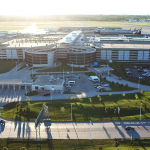Chairman Lipscomb Responds to Administration Proposal to Charge for Lakefront Parking
Asks, “Who would want to impose a tax on Independence Day celebrations and family picnics at the lakefront?”
Tonight a listening session on the 2017 Budget is being held by Milwaukee County Executive Chris Abele from 5:30 – 7:30 PM at the Washington Park Senior Center, 4220 W. Vliet St., Milwaukee. At an earlier session on the annual County budget this week, the Administration shared its proposal to charge parking fees along the lakefront.
In response to this proposal to charge for parking along Lincoln Memorial Drive, and at lots at McKinley Park, Veterans Park, North Point, Bradford Beach, and Lake Park, Board Chairman Theodore Lipscomb, Sr. released the following statement:
“I am concerned that the County Executive’s latest proposal, essentially an admission price on the lakefront, would limit access to these public spaces and make this parkland exclusive only to those who can afford added parking fees and tickets.
I urge the County Executive to ditch this retread of a 2009 Scott Walker revenue scheme. Instead, I want to work with the County Executive to find ways to make it easier, not harder, for more citizens to enjoy their lakefront.”
Milwaukee residents are encouraged to take the opportunity to participate in tonight’s budget session and share their opinions about this parks proposal and other recommendations recently advanced by the County Executive’s Administration, including the elimination of the popular GO Pass transit program for seniors and persons with disabilities and the imposition of a $20 – $60 wheel tax on Milwaukee County residents.
NOTE: This press release was submitted to Urban Milwaukee and was not written by an Urban Milwaukee writer. While it is believed to be reliable, Urban Milwaukee does not guarantee its accuracy or completeness.






















Hey Lipscomb, maybe you should have thought of the parks budget shortfall when you voted to give away the O’Donnell parking garage… another example of the excellent leadership of our county board.
AG, lack of leadership and vision re: O’Donnell goes back to the Chris Abele administration. The boards’ approving the transfer of O’Donnell Park facilities was a preventive measure to keep Abele from selling the park outright for redevelopment (which he tried at least 4 different times).
When the board rejected the O’Donnell sale in December 2014, supervisors stressed the value of its million-dollar-plus annual revenue in funding the whole parks system. The museum transfer at least kept the land in public ownership and protected access to MAM and the lakefront. That was far better than losing all the O’Donnell revenue AND the entire park with the best views in Milwaukee.
Milwaukee Native, that’s an absolutely terrible way to run government. You don’t try to stop one bad idea (which couldn’t have come to fruition the way you’re saying anyway) with another bad idea. Abele would never have sold O’donnell park to let something get built on the park section… it’s not even possible except on the south portion where the MAM is itself exploring their options for developing.
Poor decision after poor decision… that’s all this is and that’s all we see form our county board.
As a MKE County resident, user and supporter of the County’s bus service and in particular our park system I did attend the first of two scheduled meetings at Wilson Park. It was well attended and the venue was enlightening and the means for participation meaningful. The presenter described certain changes in revenue sources that might close the gap, and asked participants to consider them, by ranking, and also to offer other suggestions. The presentation included a brief but very Draconian forecast of the County’s revenue streams and spending, including past, current, near-term 2017 and long-term. The 2017 and future forecast of program budget deficits was Draconian. Just the budget gap for 2017 is estimated at $56 million and likely to rise.
No one likes increased fees or taxes, especially when existing revenues are based on poor policy and leadership. Case in point. Based on an independent 2008 study by the Public Policy Forum the deferred maintenance of just the County Park’s department was $277 million. Since 2008, that number has ballooned to well over $300 million. The County Park’s is facing a $2.5 million budget gap for 2017 and is expected to rise. County Board chairman Lipscomb continues to pursue funding for the repair of the Estabrook Dam. Those costs continue to increase with a capital cost of $4.1 million. The 20-year present worth for servicing the debt and to operate and maintain the dam is over $6.8 million and will likely increase because of the under estimated cost to remove debris on an annual basis.
Perhaps if the costly repairs actually added value to the river and County residents as a whole it would be a worthy investment. However, the dam repair’s negative environmental and recreational impacts far exceed the benefits. For just a few examples, contrary to dam repair proponent arguments, the dam increases flooding and drainage problems, and the potential liability of flood damages for the County. Also, the DNR’s will no longer allow the County to continue its decades-long practice of opening the gates and draining the impoundment for seven months of the year. This former practice flushes sediment downstream and desiccates fish and wildlife habitat in the drained 100-acre impoundment. Absent the ability to flush the on-going accumulation of sediment, it will fill with polluted sediment at a faster rate, become a fetid pool and eventually limit recreational navigation. To think the federal, state and county just spent $49 million to remove 170,000 cubic yards of polluted and hazardous sediment, equal to 17,000 trucks. Only Carp and some (not all) of the 160 riparian landowners favor the publicly subsidized dam repair option for the exclusive purpose of operating deep drafting power boats and PWC (e.g., jet skis).
Supv. Lipscomb should show leadership by abandoning his folly to repair the Estabrook Dam. Doing so would eliminate the Park’s 2017 budget gaps of $2.5 million with over $2 million in change. And while he is at it, he should offer his own means for closing the exploding gap in County revenue and expenditures without borrowing it from us and future generations.
Truth Be Told, how do you feel about the Lake Park bridge? The cost of that looks like it’s nearly $3 million dollars… I’d argue that bridge offers far less benefit than the Dam does. At least the dam provides recreational opportunities to a low income part of the city providing experiences for people who would have absolutely zero chances to do those types of things otherwise. Not to mention removing the bridge would have little impact on any property values (even if both sides inflate the effects of property values, there certainly will be some). Not to mention that the Dam already has a dedicated funding source for a good chunk of it’s repair and maintenance…
Free parking in the parks discourages healthy lifestyles. The parks were developed to provide recreational opportunities for “the masses.” People can bike or walk after parking in nearby parking structures. The free bikes are equipped with baskets to carry their beer. Additionally, a bus route along the lakefront could be started.
The proposed parking fees are minimal. Perhaps people could economize by buying one less six-pack to bring with them. I realize that less alcohol would be a hardship for the majority of our citizens but it is a small sacrifice.
AG, use of Lake Park is racially and culturally diverse as is use of other lakefront parks. The role of large “signature” parks in our system has always been to attract countywide use.
The Ravine Road Bridge is essential to a mile-long path through the center of the park designed by Olmsted. Demolishing the bridge would sever that route.
With $300 million in deferred parks maintenance, and without dedicated funding, the needs of each park will continue to be pitted against all the others. However, this bridge project could be eligible for federal funding through a Transportation Alternatives Program grants. The county has received federal grants to repair other bridges and to create trails, etc. They cover up to 80 percent of the costs.
AG, the quasi-public Milwaukee Art Museum initiated the O’Donnell agreement, which protects both the public’s interests and the museum’s access through O’Donnell and long-term parking. The board and Abele were consulted as the plan was vetted, as were parks advocates and neighbors.
All things considered, it seems it will be positive on many fronts. The county loses the parking income but the museum has pledged to invest in improvements and programming, which the county was not doing.
Long-term protection of public and MAM access was not part of NML’s contract nor Abele’s later proposed RFPs to sell off the park. Chris Abele apparently doesn’t know the difference between a “conservancy” agreement meant to protect and preserve a park and a contract like NML’s that protected only NML’s interests long-term. Even longtime deed restrictions could have been lifted by the city at NML’s request.
To AG: The capital cost of the Lake Park Bridge is $3 mil., minimal operation and maintenance and a life cycle of 50 or more years, and 80% of the cost covered by grants. As Virginia stated, “Lake Park is racially and culturally diverse as is use of other lakefront parks. The role of large “signature” parks in our system has always been to attract countywide use. The Ravine Road Bridge is essential to a mile-long path through the center of the park designed by Olmsted. Demolishing the bridge would sever that route.” The views are breathtaking and unique in Milwaukee County. The transportation, trail linkage, recreational, historic, aesthetic, and other values do not decrease over time. There are no negative environmental impacts, near or long-term. It benefits ALL County residents. It does not subsidize unique private interests.
Now the Estabrook Dam. The capital costs for repairs continue to increase. As of July they were $4.1 mil. A $613,000 shortfall in available funds. Something to pass onto the next generation…the 20-year total present worth for servicing the debt and to operate and maintain (O&M) the dam is over $6.8 mil. The County’s own consultant estimate for O&M is $160,000 per year. The estimated cost just for annual debris removal from 1/3 of the spillway is $50,000. The consultant did not include debris removal for the rest of the spillway which accumulates the lion’s share of debris and where access is difficult and via a long and narrow private easement, so that number coud easily double. Supv. Lipscomb managed to have the $51,000 of radio/TV tower leases be designated for the dam O&M instead of going to the Park’s general fund for all the Board to vet amongst other more deserving County projects (more political bullying and gamesmanship by the Chair). That leaves an O&M unfunded balance of $109,000 (closer to $150,000) that the County must find through the annual budgeting process that competes with other more sustainable projects that benefit ALL County residents and taxpayers. The proposed repairs are a Band-Aid at best. According to the dam structural engineering report, in 20-years the dam will be 100-yrs old. The core concrete is so bad there is a good chance the entire gated section of spillway will have to be removed and replaced. That cost would dwarf today’s repair cost of $4.1 mil.
An argument to repair the dam might be had if the near and long-term value of the impoundment were sustainable. For decades the dam gates were open every fall for 7 months that allowed debris and contaminated sediment to wash downstream, desiccating and freezing out fish and wildlife and their habitats. Finally, the DNR’s Operational Order will put a stop to that practice. MRPA proponents to repair the dam argued the impoundment does not collect sediment. Well here is a little factoid for them to see what’s coming. The federal EPA, state DNR and county just spent $49 million to remove 170,000 cubic yards of polluted and hazardous sediment, equal to 17,000 trucks. That was just what was highly contaminated and hazardous. There is a lot more that remains. So much for the Estabrook impoundment not being able to settle sediment. Just take a walk or canoe ride along the “east oxbow” to see what the County residents an taxpayers and riparian landowners can look forward to for the rest of the impoundment once the County ceases flushing the “toilet”. It won’t be long before backwaters turn into an algae and weed infested turbid and fetid pool. Only Carp and some (not all) of the 160 riparian landowners favor the publicly subsidized dam repair option for the exclusive purpose of operating deep drafting power boats and PWC (e.g., jet skis).
Odd that riparian’s are so worried about reduced property values should the dam be removed. Yet for several decades they never worried about the property values decreasing for 7 months out of 12. Riparian’s and County residents do not lose property value in the absence of the dam and impoundment. They still own water frontage to the center of the river channel. They still have direct access to the water’s edge and economic value assessed for the same. Only one use changes. Power boats, skinning and jet skis won’t be able to navigate after the spring of the year. Other forms of navigation by canoe, kayak and small skiffs with outboards will have no problem. Aside from navigation, absent the dam and impoundment, water quality and fishing will improve (except for carp), reduced turbidity, more wetland habitat for wildlife, and greatly reduced deposition by contaminated sediment which makes for better wading, aesthetics, etc. So what sort of water-based recreational amenity would you prefer the rest of County residents be subjected to, including low income residents? In addition to improved environmental and recreational uses by removing the dam, allocated dollars for dam repair could be used to improve the degraded park ponds scattered throughout County districts many of which are located in neighborhoods dominated by low income families with limited transportation. McGovern Park and Washington Park ponds are but a few. Would low income residents prefer a creel of foul carp or Lake Michigan run walleye? Do you think that low income families have direct water frontage to dock their speed boats and jet skis that can cost in the 10’s of thousands of dollars?
Do you want to debate which dam management alternative provides for environmental justice? Take a good look at the quality of the environment and recreational opportunities that came about along the Milwaukee River since the North Ave. dam was removed in 1997 just a few miles downstream. The demographics of neighborhood adjoin that 2 mile reach of river are similar to those around Estabrook Park.
Lastly, the MRPA and Supv. Lipscomb argue that the dam was constructed to restore the historical “natural lake” that existed in Lincoln and Estabrook Park before channelization of the river and removal of the natural rock escarpment that existed there, and also to alleviate flood damage. The dam did not restore the natural “river” that existed. The dam created an artificial man-made impoundment that is from 0.5 to 2 feet deeper; 1-mile longer; up to 350 ft wider and 38 acres larger (equal to 50 football fields than the “natural river” that existed historically. The dam did not restore anything. It destroyed a meandering river with riverine fish and wildlife habitat, and hundreds of acres of wetlands. An engineering study concluded that the dam does not abate flooding; it INCREASES it and the liability to the County for its operation.
Back in February there was an OpEd piece in Urban Milwaukee that responded to the MRPA and their consultant’s OpEd arguments that repair of the Estabrook Dam was best for the County and its residents. I’m still waiting to review the response from the MRPA, point by point. In case you care to do so, here is the link.
https://static1.squarespace.com/static/55157271e4b0179c6ec8b662/t/56e342154c2f8502d979d2aa/1457734177488/EstabrookDam_ver_FINAL+03112016.pdf